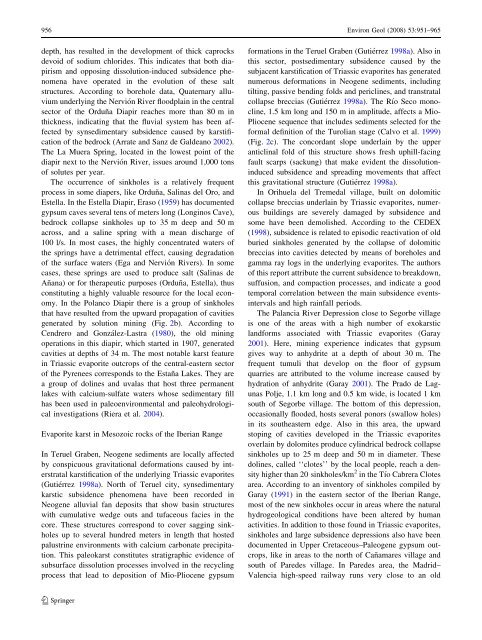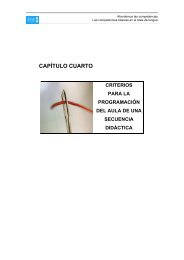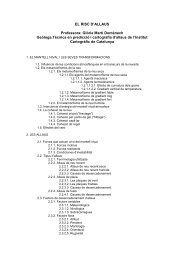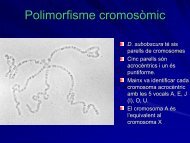Geological and environmental implications of the evaporite karst in Spain
Geological and environmental implications of the evaporite karst in Spain
Geological and environmental implications of the evaporite karst in Spain
You also want an ePaper? Increase the reach of your titles
YUMPU automatically turns print PDFs into web optimized ePapers that Google loves.
956 Environ Geol (2008) 53:951–965<br />
depth, has resulted <strong>in</strong> <strong>the</strong> development <strong>of</strong> thick caprocks<br />
devoid <strong>of</strong> sodium chlorides. This <strong>in</strong>dicates that both diapirism<br />
<strong>and</strong> oppos<strong>in</strong>g dissolution-<strong>in</strong>duced subsidence phenomena<br />
have operated <strong>in</strong> <strong>the</strong> evolution <strong>of</strong> <strong>the</strong>se salt<br />
structures. Accord<strong>in</strong>g to borehole data, Quaternary alluvium<br />
underly<strong>in</strong>g <strong>the</strong> Nervión River floodpla<strong>in</strong> <strong>in</strong> <strong>the</strong> central<br />
sector <strong>of</strong> <strong>the</strong> Orduña Diapir reaches more than 80 m <strong>in</strong><br />
thickness, <strong>in</strong>dicat<strong>in</strong>g that <strong>the</strong> fluvial system has been affected<br />
by synsedimentary subsidence caused by <strong>karst</strong>ification<br />
<strong>of</strong> <strong>the</strong> bedrock (Arrate <strong>and</strong> Sanz de Galdeano 2002).<br />
The La Muera Spr<strong>in</strong>g, located <strong>in</strong> <strong>the</strong> lowest po<strong>in</strong>t <strong>of</strong> <strong>the</strong><br />
diapir next to <strong>the</strong> Nervión River, issues around 1,000 tons<br />
<strong>of</strong> solutes per year.<br />
The occurrence <strong>of</strong> s<strong>in</strong>kholes is a relatively frequent<br />
process <strong>in</strong> some diapers, like Orduña, Sal<strong>in</strong>as del Oro, <strong>and</strong><br />
Estella. In <strong>the</strong> Estella Diapir, Eraso (1959) has documented<br />
gypsum caves several tens <strong>of</strong> meters long (Long<strong>in</strong>os Cave),<br />
bedrock collapse s<strong>in</strong>kholes up to 35 m deep <strong>and</strong> 50 m<br />
across, <strong>and</strong> a sal<strong>in</strong>e spr<strong>in</strong>g with a mean discharge <strong>of</strong><br />
100 l/s. In most cases, <strong>the</strong> highly concentrated waters <strong>of</strong><br />
<strong>the</strong> spr<strong>in</strong>gs have a detrimental effect, caus<strong>in</strong>g degradation<br />
<strong>of</strong> <strong>the</strong> surface waters (Ega <strong>and</strong> Nervión Rivers). In some<br />
cases, <strong>the</strong>se spr<strong>in</strong>gs are used to produce salt (Sal<strong>in</strong>as de<br />
Añana) or for <strong>the</strong>rapeutic purposes (Orduña, Estella), thus<br />
constitut<strong>in</strong>g a highly valuable resource for <strong>the</strong> local economy.<br />
In <strong>the</strong> Polanco Diapir <strong>the</strong>re is a group <strong>of</strong> s<strong>in</strong>kholes<br />
that have resulted from <strong>the</strong> upward propagation <strong>of</strong> cavities<br />
generated by solution m<strong>in</strong><strong>in</strong>g (Fig. 2b). Accord<strong>in</strong>g to<br />
Cendrero <strong>and</strong> González-Lastra (1980), <strong>the</strong> old m<strong>in</strong><strong>in</strong>g<br />
operations <strong>in</strong> this diapir, which started <strong>in</strong> 1907, generated<br />
cavities at depths <strong>of</strong> 34 m. The most notable <strong>karst</strong> feature<br />
<strong>in</strong> Triassic <strong>evaporite</strong> outcrops <strong>of</strong> <strong>the</strong> central-eastern sector<br />
<strong>of</strong> <strong>the</strong> Pyrenees corresponds to <strong>the</strong> Estaña Lakes. They are<br />
a group <strong>of</strong> dol<strong>in</strong>es <strong>and</strong> uvalas that host three permanent<br />
lakes with calcium-sulfate waters whose sedimentary fill<br />
has been used <strong>in</strong> paleo<strong>environmental</strong> <strong>and</strong> paleohydrological<br />
<strong>in</strong>vestigations (Riera et al. 2004).<br />
Evaporite <strong>karst</strong> <strong>in</strong> Mesozoic rocks <strong>of</strong> <strong>the</strong> Iberian Range<br />
In Teruel Graben, Neogene sediments are locally affected<br />
by conspicuous gravitational deformations caused by <strong>in</strong>terstratal<br />
<strong>karst</strong>ification <strong>of</strong> <strong>the</strong> underly<strong>in</strong>g Triassic <strong>evaporite</strong>s<br />
(Gutiérrez 1998a). North <strong>of</strong> Teruel city, synsedimentary<br />
<strong>karst</strong>ic subsidence phenomena have been recorded <strong>in</strong><br />
Neogene alluvial fan deposits that show bas<strong>in</strong> structures<br />
with cumulative wedge outs <strong>and</strong> tufaceous facies <strong>in</strong> <strong>the</strong><br />
core. These structures correspond to cover sagg<strong>in</strong>g s<strong>in</strong>kholes<br />
up to several hundred meters <strong>in</strong> length that hosted<br />
palustr<strong>in</strong>e environments with calcium carbonate precipitation.<br />
This paleo<strong>karst</strong> constitutes stratigraphic evidence <strong>of</strong><br />
subsurface dissolution processes <strong>in</strong>volved <strong>in</strong> <strong>the</strong> recycl<strong>in</strong>g<br />
process that lead to deposition <strong>of</strong> Mio-Pliocene gypsum<br />
123<br />
formations <strong>in</strong> <strong>the</strong> Teruel Graben (Gutiérrez 1998a). Also <strong>in</strong><br />
this sector, postsedimentary subsidence caused by <strong>the</strong><br />
subjacent <strong>karst</strong>ification <strong>of</strong> Triassic <strong>evaporite</strong>s has generated<br />
numerous deformations <strong>in</strong> Neogene sediments, <strong>in</strong>clud<strong>in</strong>g<br />
tilt<strong>in</strong>g, passive bend<strong>in</strong>g folds <strong>and</strong> pericl<strong>in</strong>es, <strong>and</strong> transtratal<br />
collapse breccias (Gutiérrez 1998a). The Río Seco monocl<strong>in</strong>e,<br />
1.5 km long <strong>and</strong> 150 m <strong>in</strong> amplitude, affects a Mio-<br />
Pliocene sequence that <strong>in</strong>cludes sediments selected for <strong>the</strong><br />
formal def<strong>in</strong>ition <strong>of</strong> <strong>the</strong> Turolian stage (Calvo et al. 1999)<br />
(Fig. 2c). The concordant slope underla<strong>in</strong> by <strong>the</strong> upper<br />
anticl<strong>in</strong>al fold <strong>of</strong> this structure shows fresh uphill-fac<strong>in</strong>g<br />
fault scarps (sackung) that make evident <strong>the</strong> dissolution<strong>in</strong>duced<br />
subsidence <strong>and</strong> spread<strong>in</strong>g movements that affect<br />
this gravitational structure (Gutiérrez 1998a).<br />
In Orihuela del Tremedal village, built on dolomitic<br />
collapse breccias underla<strong>in</strong> by Triassic <strong>evaporite</strong>s, numerous<br />
build<strong>in</strong>gs are severely damaged by subsidence <strong>and</strong><br />
some have been demolished. Accord<strong>in</strong>g to <strong>the</strong> CEDEX<br />
(1998), subsidence is related to episodic reactivation <strong>of</strong> old<br />
buried s<strong>in</strong>kholes generated by <strong>the</strong> collapse <strong>of</strong> dolomitic<br />
breccias <strong>in</strong>to cavities detected by means <strong>of</strong> boreholes <strong>and</strong><br />
gamma ray logs <strong>in</strong> <strong>the</strong> underly<strong>in</strong>g <strong>evaporite</strong>s. The authors<br />
<strong>of</strong> this report attribute <strong>the</strong> current subsidence to breakdown,<br />
suffusion, <strong>and</strong> compaction processes, <strong>and</strong> <strong>in</strong>dicate a good<br />
temporal correlation between <strong>the</strong> ma<strong>in</strong> subsidence events<strong>in</strong>tervals<br />
<strong>and</strong> high ra<strong>in</strong>fall periods.<br />
The Palancia River Depression close to Segorbe village<br />
is one <strong>of</strong> <strong>the</strong> areas with a high number <strong>of</strong> exo<strong>karst</strong>ic<br />
l<strong>and</strong>forms associated with Triassic <strong>evaporite</strong>s (Garay<br />
2001). Here, m<strong>in</strong><strong>in</strong>g experience <strong>in</strong>dicates that gypsum<br />
gives way to anhydrite at a depth <strong>of</strong> about 30 m. The<br />
frequent tumuli that develop on <strong>the</strong> floor <strong>of</strong> gypsum<br />
quarries are attributed to <strong>the</strong> volume <strong>in</strong>crease caused by<br />
hydration <strong>of</strong> anhydrite (Garay 2001). The Prado de Lagunas<br />
Polje, 1.1 km long <strong>and</strong> 0.5 km wide, is located 1 km<br />
south <strong>of</strong> Segorbe village. The bottom <strong>of</strong> this depression,<br />
occasionally flooded, hosts several ponors (swallow holes)<br />
<strong>in</strong> its sou<strong>the</strong>astern edge. Also <strong>in</strong> this area, <strong>the</strong> upward<br />
stop<strong>in</strong>g <strong>of</strong> cavities developed <strong>in</strong> <strong>the</strong> Triassic <strong>evaporite</strong>s<br />
overla<strong>in</strong> by dolomites produce cyl<strong>in</strong>drical bedrock collapse<br />
s<strong>in</strong>kholes up to 25 m deep <strong>and</strong> 50 m <strong>in</strong> diameter. These<br />
dol<strong>in</strong>es, called ‘‘clotes’’ by <strong>the</strong> local people, reach a density<br />
higher than 20 s<strong>in</strong>kholes/km 2 <strong>in</strong> <strong>the</strong> Tío Cabrera Clotes<br />
area. Accord<strong>in</strong>g to an <strong>in</strong>ventory <strong>of</strong> s<strong>in</strong>kholes compiled by<br />
Garay (1991) <strong>in</strong> <strong>the</strong> eastern sector <strong>of</strong> <strong>the</strong> Iberian Range,<br />
most <strong>of</strong> <strong>the</strong> new s<strong>in</strong>kholes occur <strong>in</strong> areas where <strong>the</strong> natural<br />
hydrogeological conditions have been altered by human<br />
activities. In addition to those found <strong>in</strong> Triassic <strong>evaporite</strong>s,<br />
s<strong>in</strong>kholes <strong>and</strong> large subsidence depressions also have been<br />
documented <strong>in</strong> Upper Cretaceous–Paleogene gypsum outcrops,<br />
like <strong>in</strong> areas to <strong>the</strong> north <strong>of</strong> Cañamares village <strong>and</strong><br />
south <strong>of</strong> Paredes village. In Paredes area, <strong>the</strong> Madrid–<br />
Valencia high-speed railway runs very close to an old





